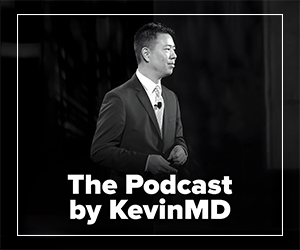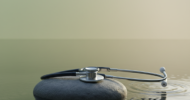She was pale, underweight, fifty years old and scared. Mrs. G was a breast cancer patient on the oncology unit whom I met by chance, as she appeared on my patient census list that morning. As I walked into her room, I noticed the fragrant flowers, the cards scattered about her hospital tray, and the numerous pictures of her friends and family that attempted to bring her peace and comfort. But she looked uncomfortable. Her port located on the upper part of her chest was red and angry. She had a blood infection, and her chemotherapy was placed on hold. “I just want to be done with this and ring that bell before Christmas!” she told me. She had to be on six weeks of intravenous antibiotics and her port needed to be removed. Her treatment would extend beyond Christmas. She knew this and I walked in as she cried.
Me, on the other hand? I was the 40-something hospital medicine physician. I was healthy. I only had high blood pressure and took one low dose medication to temper this. Breast cancer was a disease that seemed so distant from me. It could never happen to me. But it did.
I went in for a routine screening mammogram on my day off, only to be called on my cell phone a few hours later. The voice on the other end said, “You have left breast asymmetry and need further diagnostic tests.” I was on my way to pick up my kids from school and my stomach dropped. Asymmetry? What does that even mean? Being the doctor, I looked it up on the many evidence-based medicine websites to which I have access. It means an abnormality seen only in one view. OK. Maybe that was an artifact, a mistake, or just a shadow? Any which way I could, I tried to rationalize the situation so I wouldn’t be in panic mode. I still needed to go to work. I still needed to keep everything normal, especially for my kids.
A few weeks later, I went in for further diagnostic tests, which included a more detailed mammogram to hone in on the “asymmetry” and an ultrasound. This time, I didn’t have to wait for a call. The radiologist met me in the room and told me, “It’s definitely a mass. You need a core needle biopsy.” OK. I’m wearing a pink gown with the imprint of flowers and my face flushes, my mind races, and my heart beats faster. What is even happening??? I’m a physician. I don’t like this. I absolutely dislike being the patient.
Fast forward another week, the core needle biopsy is done, and it’s a Saturday. I’m home with my kids and my cell phone rings. I jump up and take the call in the bathroom. “The mass is benign…but it contains atypical cells. I need to refer you to a breast surgeon.” OK.
I feel relief yet confusion at the same time. Atypical cells? What does this even mean? My doctor brain switches on and I look up everything I can, take notes, and try to rationalize the situation. I even look up every single breast disease this could be and try to mentally prepare myself. A fibroadenoma. OK. I’ve had this previously and had this removed in my 20s. A phyllodes tumor. OK. Most are benign. And that’s as far as I let my research go. I didn’t want to research anything beyond that because this simply cannot be breast cancer.
I eventually met with my breast surgeon, had an excisional biopsy, and then waited. The waiting is literally the worst. All this time, I’m expected to go about life as usual while waiting for a call that could literally make or break me. I’m trying to be cheerful at work, with the nurses and with my patients. I’m trying to help my kids with their homework. I’m trying to make light of the situation with my husband. Yet, I’m absolutely numb. Did I just go through a lumpectomy under general anesthesia?
It was dinnertime when my cell phone rang a few weeks later. By the area code and caller ID, I knew it was the breast surgeon. I had already looked at my pathology results online. I already knew the results. Somehow, the breast surgeon saying it aloud made it more real. “You have breast cancer. Let’s meet tomorrow to discuss options.”
My heart sank. I went out of the backroom where I was hiding during that phone call. I looked at my kids and husband and ran to hide and started crying. I didn’t want my kids to see mommy like this. My emotions were literally all over the place from that night onward.
Just a few weeks ago, I took care of a 50-something breast cancer patient in the hospital with sepsis, a port infection, and blood infection. She just wanted to be done with chemo before Christmas. Was this going to be me? Being a physician made me know too much and for this, I was absolutely terrified. I am a mother. I am a wife. I am a doctor. And now I was thrown into becoming a breast cancer fighter when I didn’t want to be. Pink was never my color, but it certainly is now.
My past mammograms were normal, so how could this be? The good news was my breast cancer was caught extremely early at Stage 0. L-sided DCIS intermediate grade. I opted to undergo bilateral mastectomies and, on sentinel lymph node biopsy, the cancer thankfully did not spread. The final pathology did show abnormalities on the healthy R side not caught on imaging, so I knew I made the right decision. I’m currently showing no evidence of disease, and a huge weight has been lifted off my heart and shoulders.
I was fortunate mine was caught early, and this illustrates the importance of mammograms and keeping up with your screenings.
One in eight women will get breast cancer in their lifetime. Mammogram screenings begin at the age of 40 or earlier with family history, suspicious findings, or a high lifetime risk of developing breast cancer. Tools are available to learn about this, so ask your doctor. I wrote this article to bring more awareness to breast cancer. I never thought this would happen to me, but it did. Breast cancer was never supposed to be part of my story. Now that it is, my new life’s mission is to spread the word about mammograms. It could save your life like it did mine. For this, I am forever thankful to God and advanced medical science. Now, I can say I’m a mother, a wife, a doctor, and a breast cancer survivor.
The author is an anonymous physician.






















![Collaborative partnerships save rural health care from collapse [PODCAST]](https://kevinmd.com/wp-content/uploads/Design-3-190x100.jpg)
